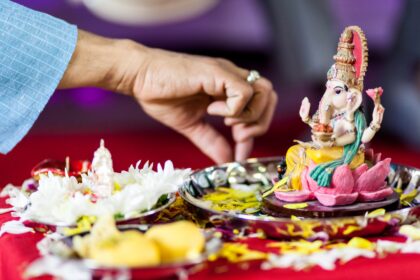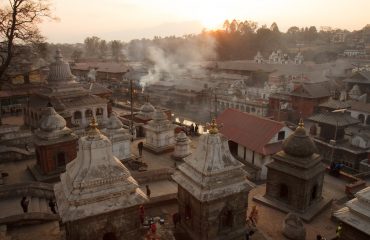
What is Puja and Why Should we Perform?
Revealed by the ancient sages, and passed on for thousands of years without changes, puja is the science and art of invoking and honoring the living presence of God with love and devotion.
The Sanskrit mantras and practices of traditional puja come to us from the Vedas, Puranas, and Tantras. The main goal of puja is the offering of our loving devotion to the Lord of our hearts.
Puja awakens divine vibrations and aligns us with cosmic forces, bringing peace, solace, sustenance, and happiness into our lives and places of work.
Puja is an auspicious way to celebrate important events in your life such as moving into a new place, starting a new business, birthdays anniversary, or any other occasion simply to invoke the blessings of God in your and your family’s lives through devoted worship.
Performing a puja in the home brings the blessings of the Divine to the household. The sacred mantras and rites of traditional worship remove negative energies and fill the home with a tangible presence of auspiciousness.
Puja — ceremonial worship which consists of the making of offerings consisting of flowers, fruit, incense, and cooked food. etc.
Yajña —a ceremony that involves the making of oblations of ghee, havan samagri, sticks, etc. into a consecrated fire. (same as homa or havan).
1. Punyaha Vachana — a purification ceremony done after a death or birth or any other occasion in which personal or environmental pollution has occurred.
2. General Puja — a formal making of offerings to one’s chosen deity to either invoke blessings, show appreciation or simply “connect” with the divine. In this ceremony, there is no havan (i.e. no fire offerings.)
3. Satya Narayana Puja — An all-inclusive puja in which offerings are made to all the deities in order to invoke their blessings and goodwill. The principal deities are Vishnu & Lakshmi and the purpose of the ceremony is thanksgiving.
4. Lakshmi-Narayana Puja — This is a fire ceremony to invoke the blessings and grace of the Supreme Being appearing in the joint form of Lakshmi and Narayana.
Narayana is the protective aspect of the Godhead and Lakshmi is the manifestation of Divine Compassion. Narayana creates and preserves the cosmos and mother Lakshmi as the goddess of compassion requires us to use all resources for the benefit of all beings living on this planet. So these yajnas are performed for the benefit of all beings and to create harmony and balance in the world and environment.
5. Vastu Shanti / Griha Pravesha— Entering a new home.
A Vedic ceremony was done in order to regulate any imbalance of energy in the home or office space. All enclosed spaces create an energy field that is further conditioned by the auras of the people who use the space and the interpersonal dynamics that occur. The purpose of this ceremony is to transmute the negative into a positive beneficial force and to remove all obstructive elements.
6. Ganesha Homa — A fire Ritual for the removal of all obstacles and for achieving astrological harmony and empowerment. Ganesha is the principle of Wisdom. Through this ceremony the dormant principle of wisdom – the enlightened mind is activated. This is also a very potent method of dealing with problems in one’s birth chart either due to natal influences or transits through negative periods (Dashas). The ritual empowers one to deal effectively and constructively with one’s Karma.
7. Navagraha Shanti — A ritual for invoking the blessings of the Nine Planetary deities.
The Nine Planetary deities (Grahas) are the agents through which we experience the positive and negative results of our Karma. This ceremony which can be done with or without the medium of fire is done to make offerings to them and to invoke their blessings in order to maximize our potential to utilize both negative and positive Karma as vehicles for enlightenment. This is an empowerment ceremony — it does not “remove” bad Karma.
8. Sudarshana Homa — A fire ritual that is done to achieve protection — either spiritual or for some physical purpose. Sudarshana is the personification of the Discus held by Lord Vishnu. It is representative of the all-pervading Cosmic Mind. Sudarshana is one of the “wrathful” deities and is invoked along with Narasimha for protecting the spiritual aspirant from all negative forces that may be at work disturbing their lives and their practice. The ritual can also be seen as a type of exorcism that removes elementals and other troublesome astral entities as well as counteracting curses and spells.
9. Hayagriva Puja — Hayagriva is the Hindu/Buddhist deity of knowledge and skillful means. This is a ceremony in which offerings are made to Hayagriva in order to invoke his blessings and to maximize the learning potential and the ability to actualize spiritual practice. This can also be done with fire offerings if required.
10. Durga Puja — Durga or Kali is the cosmic mother, the Great Goddess. This is a ritual of making offerings in order to show our appreciation of the Divine and to harmonize with her all-pervading energy. This can also be done with the recitation of appropriate stotras and or the recitation of Chandi Paath — please discuss this with your priest.
11. Shiva Puja /Rudra-Abhishekam — A puja ceremony to express gratitude to Lord Shiva and to invoke his blessings. This can also be done along with Rudra Mahimna Stotra and or Rudra Japa.
12. Mrityunjaya Homa — A fire-ceremony ceremony to invoke the grace of Lord Shiva and to bless an individual with health and longevity. Can be done on birthdays or anniversaries or whenever one desire.
13. Ayushya Homa — A fire-ceremony ceremony to invoke the grace of the gods and to bless an individual with long life. Can be done on birthdays or anniversaries or whenever one desire.
14. Lakshmi Puja/Homa — This ceremony is intended to invoke the blessings and grace of Mother Lakshmi for the achievement of prosperity, domestic happiness, and general well-being. It can be done either as a puja or as a home — or both combined.
Shraddha Ceremonies There are many variations of Shraddha and various degrees of complexity ranging from simply offering raw foodstuffs and Dakshina to a Brahmin (hiranya shraddha), the performance of tarpana — offering of water libations, or even the inviting of two or three Bhoktas for a formal Shraddha meal.



